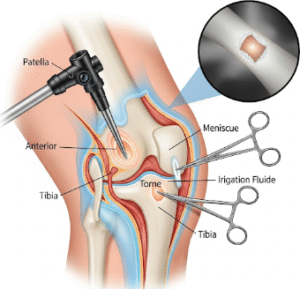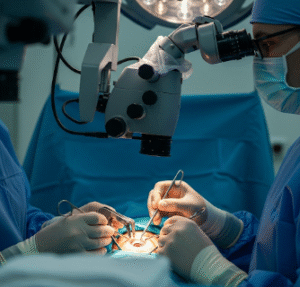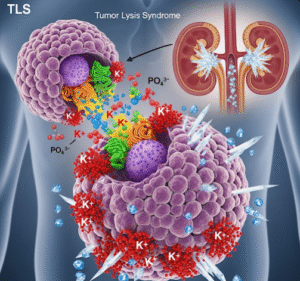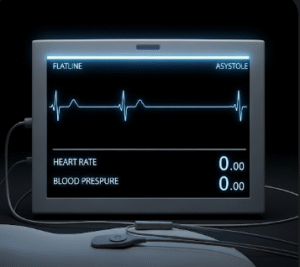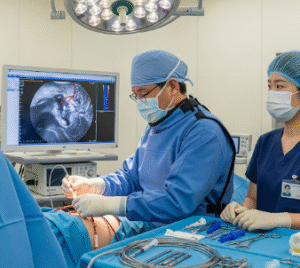What it is
An IUS (intrauterine system), commonly called a hormonal coil, is a small, T-shaped device inserted into the uterus that releases progestin, a synthetic hormone, to prevent pregnancy. Unlike the copper IUD, the IUS provides hormonal contraception and also helps regulate menstrual bleeding.
Key points:
- Long-acting reversible contraception (LARC): Effective for 3–7 years, depending on the type.
- Hormonal method: Releases progestin to thicken cervical mucus, thin the uterine lining, and inhibit ovulation partially.
- Highly effective: Over 99% effective in preventing pregnancy.
- Reversible: Fertility typically returns quickly after removal.
Why it’s done
Hormonal IUS is used for several purposes:
- Prevent unintended pregnancy: Provides reliable long-term contraception.
- Heavy menstrual bleeding (menorrhagia): Reduces blood loss and cramps.
- Endometriosis-related symptoms: Can decrease pain and lesion growth.
- Alternative to estrogen-based contraception: Suitable for women who cannot take combined hormonal methods.
- Postpartum contraception: Can be inserted after childbirth or abortion for ongoing contraception.
Note: IUS does not protect against sexually transmitted infections (STIs); barrier methods may still be recommended for STI prevention.
Alternatives
Other contraceptive options include:
- Copper IUD: Non-hormonal, long-acting contraception.
- Oral contraceptives: Pills for daily hormonal regulation.
- Implants, injections, or patches: Other hormonal long-acting or short-term methods.
- Barrier methods: Condoms, diaphragm, cervical cap.
- Sterilization: Permanent contraception via tubal ligation.
Important: The IUS is preferred for long-term hormonal contraception and for women with heavy periods or menstrual disorders.
Preparation
Preparation ensures safe insertion and optimal effectiveness:
- Consultation: Review medical history, menstrual patterns, allergies, previous pregnancies, and gynecological conditions.
- Screening: Pelvic exam and sometimes STI tests.
- Timing: Usually inserted during menstruation or at a convenient point in the cycle.
- Informed consent: Discuss benefits, potential side effects, duration, and follow-up.
Patient instructions:
- Avoid insertion during active pelvic infection.
- Consider taking mild pain relief before the procedure if needed.
- Arrange for a brief rest period after insertion.
How it’s done
IUS insertion is a short outpatient procedure:
- Patient positioning: Lie on an exam table with legs in stirrups.
- Cervical preparation: Clean the vagina and cervix; local anesthetic or cervical dilator may be used in some cases.
- Insertion: The IUS is loaded into an inserter and placed carefully inside the uterine cavity.
- Final placement: The T-shaped device deploys properly inside the uterus.
- Trimming strings: Strings extend slightly into the vagina for future removal or monitoring.
Duration: Usually 5–10 minutes. Mild cramping during and after insertion is common.
Recovery / Post-Procedure Considerations
Recovery is generally quick and uncomplicated:
- Mild cramping or spotting: May last a few days to a few weeks.
- Return to normal activities: Typically immediate; avoid heavy lifting if discomfort occurs.
- Follow-up check: Often 4–6 weeks post-insertion to ensure correct positioning.
- Monitoring: Check IUS strings periodically to confirm device remains in place.
Benefits of correct use:
- Long-term hormonal contraception with minimal daily attention.
- Reduces menstrual bleeding and cramping.
- Rapid return to fertility after removal.
Complications / Risks
Hormonal IUS is generally safe, but potential issues include:
- Cramping or back pain: Mild, common during first days.
- Spotting or irregular bleeding: Can last several months.
- Expulsion: Rare; the device may partially or fully come out.
- Perforation: Very rare; device may pass through the uterine wall.
- Hormonal side effects: Possible breast tenderness, acne, mood changes, or headaches.
- Infection: Slight risk during insertion, preventable with hygiene measures.
Prevention:
- Performed by a trained gynecologist.
- Attend follow-up checks to ensure proper placement.
- Monitor for unusual pain, fever, or discharge and seek medical attention if needed.
Treatment Options in Korea
Hormonal IUS is widely available in Korean hospitals, women’s health clinics, and family planning centers:
Key features:
- Offered in both public and private healthcare facilities with experienced gynecologists.
- Different types are available with varying durations (3–7 years).
- Provides education on monitoring, side effects, and string checking.
- Alternative or complementary options such as copper IUDs, implants, and oral contraceptives are also accessible.
- Suitable for women seeking long-term, reversible contraception with hormone benefits.
Summary: Hormonal IUS (intrauterine system) in Korea is a safe, highly effective, and long-term contraceptive option. It offers reliable pregnancy prevention, reduction of heavy periods, and hormonal regulation with minimal disruption to daily life. With proper insertion, follow-up, and patient education, it provides a convenient and reversible solution for reproductive health.




